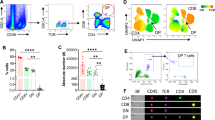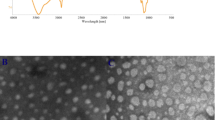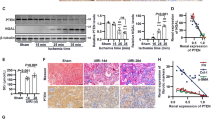Abstract
Aim:
We previously reported a novel triptolide (TP)-glucosamine conjugate (TPG) that specifically accumulated in kidneys and protected renal function from acute ischemia/reperfusion (I/R) injury in rats. In this study we further examined the molecular mechanisms underlying the renoprotective action of TPG.
Methods:
The renal-targeting of TPG was investigated in a human proximal renal tubular epithelial cell line (HK-2) by measuring cell uptake of TP or TPG. The effects of TP or TPG on cell cycle distribution and apoptosis rate of HK-2 cells were assessed, and the activities of caspase-3 and caspase-9 were also measured. SD rats were subjected to bilateral renal ischemia by temporarily clamping both renal pedicles. The rats were administered TP (4.17 μmol·kg−1·d−1, iv) or TPG (4.17 μmol·kg−1·d−1, iv) for 3 d before the renal surgery. The kidneys were harvested after 24 h of recovery from the surgery. The levels of oxidative stress, proinflammatory cytokines, chemotactic cytokines and intracellular adhesion molecules in kidneys were examined.
Results:
The uptake of TPG in HK-2 cells was 2–3 times higher than that of TP at the concentrations tested. Furthermore, TPG targeting the proximal tubules was mediated through interactions with megalin receptors. TP (40–160 nmol/L) concentration-dependently increased G2/M arrest, apoptosis and caspase-3/caspase-9 activity in HK-2 cells, whereas the same concentrations of TPG did not show those features when compared with the control group. In I/R-treated rats, TPG administration caused more robust down-regulation of proinflammatory cytokines (TNF-α, IL-6, IL-1, TGF-β) and chemotactic cytokines (MCP-1) in the kidneys compared with TP administration, suggesting the inhibition of the proliferation and accumulation of lymphocytes. And TPG administration also caused more prominent inhibition on the levels of oxidative stress and intracellular adhesion molecules in the kidneys, compared with TP administration.
Conclusion:
The renal-targeting TPG is more effective and less toxic than TP, in amelioration of I/R-induced rat renal injury, which may provide a new avenue for the treatment of acute kidney injury.
Similar content being viewed by others
Log in or create a free account to read this content
Gain free access to this article, as well as selected content from this journal and more on nature.com
or
References
Holger KE, Tobias E . Ischemia and reperfusion-from mechanism to translation. Nat Med 2011; 17: 1391–401.
Forbes JM, Hewitson TD, Becker GJ, Jones CL . Ischemic acute renal failure: long-term histology of cell and matrix changes in the rat. Kidney Int 2000; 57: 2375–85.
Macedo E, Bouchard J, Mehta R . Renal recovery following acute kidney injury. Curr Opin Crit Care 2008; 14: 660–5.
Liu HF, Liang D, Wang LM, Zhou N, Yao CW, Hong T, et al. Effects of specific interle kin-1β-converting enzyme inhibitor on ischemic acute renal failure in murine models. Acta Pharmacol Sin 2005; 26: 1345–51
Goncalves GM, Castoldi A, Braga TT, Camara NOS . New roles for innate immune response in acute and chronic kidney injuries. Scand J Immunol 2011; 73: 428–35.
Wu PF, Zhang Z, Wang F, Chen JG . Natural compounds from traditional medicinal herbs in the treatment of cerebral ischemia/reperfusion injury. Acta Pharmacol Sin 2010; 31: 1523–31
Suroj S, Weijia Z, Raju K, Kaskel FJ, Moore LC . Differential gene expression following early renal ischemia/reperfusion. Kidney Int 2003; 63: 1714–24.
Devarajan P . Update on mechanisms of ischemic acute kidney injury. J Am Soc Nephrol 2006; 17: 1503–20.
Lee SB, Kalluri R . Mechanistic connection between inflammation and fibrosis. Kidney Int 2010; 78: S22–6.
Ryota T, Yu I, Hitoshi M, Azusa K, Saori N, Hiroshi W, et al. Albumin fusion prolongs the antioxidant and anti-inflammatory activities of thioredoxin in mice with acetaminophen-induced hepatitis. Mol Pharm 2014; 11: 1228–38.
Xiao MM, David J, Nikolic P, Hui YL . Inflammatory processes in renal fibrosis. Nat Rev Nephrol 2014; 10: 493–503.
Daha M R, Kooten CV . Is the proximal tubular cell a proinflammatory cell? Nephrol Dial Transplantm 2000; 15: 41–3.
Dolman MEM, Harmsen S, Storm G, Hennink WE, Kok RJ . Drug targeting to the kidney: advances in the active targeting of therapeutics to proximal tubular cells. Adv Drug Delivery Rev 2010; 62: 1344–57.
Zhou P, Sun X, Zhang ZR . Kidney-targeted drug delivery systems. Acta Pharm Sin B 2014; 4: 37–42.
Zhou P, Sun X, Gong T, Zhang ZR, Zhang L . Conjugating glucosamine to triptolide to enhance its protective effect against renal ischemia-reperfusion injury and reduce its toxicity. J Drug Target 2014; 22: 200–10.
Ma J, Dey M, Hui Y, Poulev A, Pouleva R, Dorn R, et al. Anti-inflammatory and immunosuppressive compounds from Tripterygium wilfordii. Phytochemistry 2007; 68: 1172–8.
Hikim AP, Lue YH, Wang C, Reutrakul V, Sangsuwan R, Swerdloff RS . Posttesticular antifertility action of triptolide in the male rat: evidence for severe impairment of cauda epididymal sperm ultrastructure. J Androl 2000; 21: 431–7.
He JK, Yu SD, Zhu HJ, Wu JC, Qin ZH . Triptolide inhibits NF-κB activation and reduces injury of donor lung induced by ischemia/reperfusion. Acta Pharmacol Sin 2007; 28: 1919–23.
Amal AA, Mary JK, Phillip G . Receptor-mediated endocytosis across human placenta: emphasis on megalin. Mol Pharm 2013; 10: 1269–78.
Gujral JS, Bucci TJ, Farhood A, Jaeschke H . Mechanism of cell death during warm hepatic ischemia-reperfusion in rats: apoptosis or necrosis? Hepatology 2001; 33: 397–405.
Cuzzocrea S, Riley DP, Caputi AP, Salvemini D . Antioxidant therapy: a new pharmacological approach in shock, inflammation, and ischemia/reperfusion injury. Pharmacol Res 2001; 53: 135–59.
Granger DN, Kvietys PR . Reperfusion injury and reactive oxygen species: the evolution of a concept. Redox Biol 2015; 6: 524–51.
Chuanyu Li, Robert MJ . Reactive species mechanisms of cellular hypoxia-re oxygenation injury. Am J Physiol Cell Physiol 2002; 282: 227–41.
Senbel AM, Moneim LA, Omar AG . Celecoxib modulates nitric oxide and reactive oxygen species in kidney ischemia/reperfusion injury and rat aorta model of hypoxia/reoxygenation. Vasc Pharmacol 2014; 62: 24–31.
Vaidya VS, Ford GM, Waikar SS, Wang Y, Clement MB, Ramirez V, et al. A rapid urine test for early detection of kidney injury. Kidney Int 2009; 76: 108–14.
Takaharu I, Edwin JPA, Benjamin DH, Lakshman G, Jeremy SD, Bonventre JV . Kidney injury molecule-1 is a phosphatidylserine receptor that confers a phagocytic phenotype on epithelial cells. J Clin Invest 2008; 118: 1657–68.
Sung FL, Zhu TY, Au-Yeung KKW, Siow YL, Karmin O . Enhanced MCP-1 expression during ischemia/reperfusion injury is mediated by oxidative stress and NF-κB. Kidney Int 2012; 62: 1160–70.
Dragun D, Tullius SG, Park JK, Maasch C, Lukitsch I, Lippoldt A, et al. ICAM-1 antisense oligodesoxynucleotides prevent reperfusion injury and enhance immediate graft function in renal transplantation. Kidney Int 1998; 54: 590–602.
Christian S, Jan H, Christian J, Christian B, Erik IC, Luft FC, et al. Megalin deficiency offers protection from renal aminoglycoside accumulation. J Biol Chem 2002; 277: 618–22.
Yuan ZX, Zhang ZR, Zhu D, Sun X, Gong T, Liu J, et al. Specific renal uptake of randomly 50% N-acetylated low molecular weight chitosan. Mol Pharm 2009; 6: 305–14.
Lin Y, Li YP, Wang XH, Gong T, Zhang L, Sun X . Targeted drug delivery to renal proximal tubule epithelial cells mediated by 2-glucosamine. J Control Release 2013; 167: 148–56.
Jiang M, Dong Z . Regulation and pathological role of p53 in cisplatin nephrotoxicity. J Pharmacol Exp Ther 2008; 327: 300–7.
Price PM, Safirstein RL, Judit M . The cell cycle and acute kidney injury. Kidney Int 2009; 76: 604–13.
Yang L, Besschetnova TY, Brooks CR, Shah JV, Bonventre JV . Epithelial cell cycle arrest in G2/M mediates kidney fibrosis after injury. Nat Med 2010; 16: 535–44.
Manabu K, Sally K . Caspases and kinases in a death grip. Cell 2009; 138: 838–85.
Li XJY, Jiang ZZ, Zhang LY . Triptolide: progress on research in pharmacodynamics and toxicology. J Ethnopharmacol 2014; 155: 67–79.
Koo DDH, Fuggle SV . Impact of ischemia/reperfusion injury and early inflammatory responses in kidney transplantation. Transplant Rev 2000; 14: 210–24.
Koo DDH, Fuggle SV . Chemokines in ischemia/reperfusion injury. Curr Opin Organ Transplant 2002; 7: 100–6.
Qi M, Zheng LL, Qi Y, Han X, Xu YW, Xu L, et al. Dioscin attenuates renal ischemia/reperfusion injury by inhibiting the TLR4/MyD88 signaling pathway via up-regulation of HSP70. Pharmacol Res 2015; 100: 341–52.
Molitoris BA, Sutton TA . Endothelial injury and dysfunction: role in the extension phase of acute renal failure. Kidney Int 2004; 66: 496–9.
Ganesan R, Brian RW . TNF-α mediates chemokine and cytokine expression and renal injury in cisplatin nephrotoxicity. J Clin Invest 2002; 110: 835–42.
Nath KA, Norby SM . Reactive oxygen species and acute renal failure. Am J Med 2000; 109: 665–78.
Noiri E, Nakao A, Uchida K, Tsukahara H, Ohno M, Fujita T, et al. Oxidative and nitrosative stress in acute renal ischemia. Am J Physiol Renal Physiol 2001; 281: 948–57.
Dhalla NS Elmoselhi AB, Hatac TJ, Makino N . Status of myocardial antioxidants in ischemia–reperfusion injury. Cardiovasc Res 2000; 47: 446–56.
Kelly KJ, Williams WW, Colvin J, Meehan SM, Pringer TA, Ramos JCG, et al. Intercellular adhesion molecule-1–deficient mice are protected against ischemic renal injury. J Clin Invest 1996; 97: 1056–63.
Acknowledgements
This work was funded by the National Natural Science Foundation of China (No 81473169).
Author information
Authors and Affiliations
Corresponding author
Rights and permissions
About this article
Cite this article
Fu, Y., Lin, Q., Gong, T. et al. Renal-targeting triptolide-glucosamine conjugate exhibits lower toxicity and superior efficacy in attenuation of ischemia/reperfusion renal injury in rats. Acta Pharmacol Sin 37, 1467–1480 (2016). https://doi.org/10.1038/aps.2016.44
Received:
Accepted:
Published:
Issue date:
DOI: https://doi.org/10.1038/aps.2016.44
Keywords
This article is cited by
-
Antirheumatoid arthritis and cellular uptake study of cefuroxime axetil-loaded boswellic acids nanoparticles on RAW 264.7 cells
Future Journal of Pharmaceutical Sciences (2023)
-
Therapeutic potential of triptolide in autoimmune diseases and strategies to reduce its toxicity
Chinese Medicine (2021)



